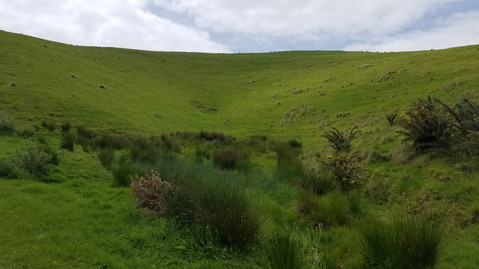Tree Planting on Motutapu!
- jocelynjohnson
- Oct 22, 2019
- 2 min read
Today I helped plant trees on the island of Motutapu (scroll down to to the bottom to read about the history of the island). We worked in the wetlands planning manuka, mamaku, mangrove and other native species. The weather was perfectly sunny and it was amazing to listen to all the native bird songs while we worked. There was even a pair of paradise ducks (native to NZ) with a group of chicks in the pond right next to us! My favorite part of the day was talking a walk in the bush after finishing our planting and getting to know some of the volunteers. Truly a lovely day.
What most of the island looks like now and the area being replanted. Bare spots in the replanted area are Maori archaeological sites and cannot be disturbed (We were told that if we came across a large rock, shell fragment or bone, to stop digging because we could be disturbing one of these sites).

In one day, we were able to plant a few hundred of the baby trees pictured above. Our volunteer coordinator noted that the wetland trees will grow faster than the trees on the hillside because the soil will have adequate moisture all year round. Because of this, the trees can grow even in the drier months. However, NZ trees grow at a very slow pace and it will probably take many years before they reach their full height.
Just a few more pictures from the day:
Motutapu: Some History
Destruction
The full name of the island is Te Motutapu a Taikehu and was inhabited by Māori up until the neighbouring island, Rangitoto, erupted around 600 years ago. Māori came back to the island after the lava and land had cooled, and the iwi, Ngai Tai, lived there until 1840 when part of the island was sold to a European settler. The land changed hands a few more times before becoming a military battery during WWII and was subsequently abandoned after the war.
New Zealand evolved without any land mammals, so many of its native birds had no defense mechanisms to protect themselves from possums, rats, cats, dogs, and other pests introduced by humans. The rats in particular also ate many of the native plant seeds, preventing them from growing.
The volcanic activity, the conversion of the land into pasture by European settlers and the introduction of pests meant that almost all of the native bush on the island had disappeared by the mid-19th century.
Rehabilitation
After noticing this disturbance in the natural ecology, conservationists began trying to rehabilitate the land. By the 1990s, all of the possums and wallabies on the island had been removed, and through a series of aerial poison drops and trapping efforts, Motutapu and Rangitoto, were declared pest free in 2011.
When the pests were removed, many of the birds and plant life, with a little help from humans, were able to bounce back. Now the island is even home to small populations of Kiwi and Takahe birds – two of New Zealand’s rare flightless birds.














































What a cool experience Joc. Good work😘